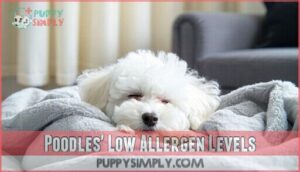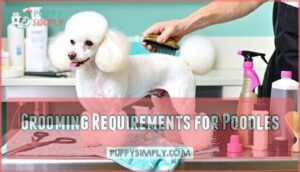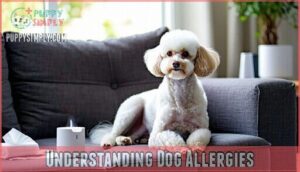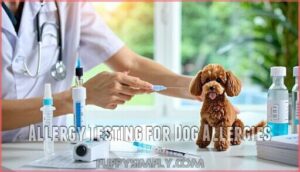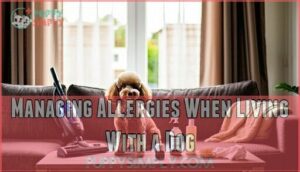This site is supported by our readers. We may earn a commission, at no cost to you, if you purchase through links.

Still, no dog breed is totally allergy-proof, so regular baths and keeping up with grooming are a must to help keep symptoms at bay.
Knowing how poodles help cut down on allergic reactions—and a few simple ways you can manage those symptoms—means your family can spend more time enjoying your pup and less time sniffling and rubbing your eyes.
Table Of Contents
- Key Takeaways
- Poodles: The Ideal Hypoallergenic Dog Breed
- Other Hypoallergenic Dog Breeds to Consider
- Understanding Dog Allergies
- Allergy Testing for Dog Allergies
- Tips for Choosing a Dog When You Have Allergies
- Managing Allergies When Living With a Dog
- Balancing Allergies and Enjoying Time With Your Dog
- Seeking Professional Help for Allergies
- Frequently Asked Questions (FAQs)
- Are poodles hypoallergenic?
- Do Poodles and allergies mix?
- Are Poodles good for allergy sufferers?
- Are Poodles allergy-proof?
- Can a poodle have an allergy-friendly home?
- How to get rid of allergies to dogs and Poodles?
- How often should you bathe a poodle if you have dog allergies?
- What should you do if your allergies get worse after bringing your poodle home?
- Can poodles trigger allergies in some people?
- How often should poodles be professionally groomed?
- Conclusion
Key Takeaways
- Poodles rank among the most hypoallergenic breeds because their curly coats trap dander and shed minimally, though no dog is completely allergen-free, and individual poodles can vary dramatically in allergen production. – About 80% of people with dog allergies report fewer symptoms around poodles compared to high-shedding breeds, making them worth considering despite the lack of guaranteed allergen reduction in every home. – Consistent grooming every 6-8 weeks, regular bathing every 2-4 weeks, and frequent brushing are essential to maintain a poodle’s hypoallergenic advantages and prevent allergen buildup in your living space. – Managing allergies alongside poodle ownership requires a multi-layered approach, including HEPA air purifiers, pet-free bedroom zones, frequent vacuuming, and consulting an allergist for personalized treatment options like immunotherapy when symptoms persist.
Poodles: The Ideal Hypoallergenic Dog Breed
If your family wants a dog but deals with allergies, poodles are a great pick. Their signature curly coats barely shed, so there’s a lot less dander floating around the house.
Poodle’s Coat Characteristics
Poodles consistently rank high for allergy sufferers because of their unique coat structure. Their curly hair grows continuously rather than shedding like traditional fur, creating a dense, wool-like texture that traps loose hair and dander before these particles can spread through your home.
So what makes poodles different from other breeds?
- Minimal Shedding Rate: Their tight curls hold onto hair that would otherwise fall out, keeping your floors and furniture cleaner.
- Exceptional Dander Reduction: The coat density prevents skin flakes from dispersing into the air you breathe.
- Continuous Growth Pattern: Hair grows steadily rather than shedding seasonally, giving you more predictable poodle care and grooming needs.
- Allergen Containment: The curly hair texture keeps allergens close to the skin instead of floating throughout your home.
While no dog is completely allergen-free, poodle breeds—whether Standard, Miniature, or Toy—offer genuine relief for many families managing pet allergies.
Poodles’ Low Allergen Levels
Lots of people with allergies turn to poodles for relief, but it’s not that straightforward. Poodles shed very little and are considered hypoallergenic, yet studies find that homes with poodles don’t always have less Can f 1 allergen than homes with other dogs.
The difference between individual poodles is huge—one study found a 60-fold variation in dander production between two dogs.
One study revealed that dander production can vary by as much as 60 times between individual poodles
That said, around 80% of people with canine allergies report fewer symptoms with poodles compared to high-shedding breeds, making them worth considering if you’re managing allergies. Understanding the characteristics of hypoallergenic dogs is essential for making informed decisions about pet ownership.
| Factor | Reality for Poodles |
|---|---|
| Can f 1 allergen levels | Varies widely between individual dogs |
| Symptom improvement | About 80% report fewer reactions |
| Shedding | Minimal compared to most breeds |
| Allergen-free guarantee | No dog is completely allergen-free |
Grooming Requirements for Poodles
While their low-shedding coat makes poodles a dream for allergy sufferers, maintaining that hypoallergenic advantage requires consistent grooming care.
You’ll need to commit to:
- Poodle brushing several times weekly to prevent matting
- Regular trimming every 6-8 weeks for curly coat care
- Bathing every 2-4 weeks for shedding control
- Nail trimming and ear cleaning
- Daily teeth brushing
Keeping up with these dog grooming tasks helps trap allergens before they spread, making your hypoallergenic poodle truly work for your family’s needs.
Other Hypoallergenic Dog Breeds to Consider
While poodles are excellent for allergy sufferers, they’re not your only option.
Several other breeds share similar low-shedding coats and reduced dander production, giving you more choices when finding the right fit for your family.
Bichon Frise
The Bichon Frise stands out among hypoallergenic dog breeds thanks to its curly, low-shedding coat that traps dander close to the body. This cheerful companion produces less dander than most breeds, earning recognition from the American Kennel Club as a top choice for allergy-friendly pets.
You’ll need to commit to Bichon grooming every four to six weeks to maintain its hypoallergenic properties and prevent allergen buildup. The Bichon Frise requires regular dog grooming sessions to prevent matting and tangling of their fur. Beyond grooming, proper dog nutrition and pet health monitoring bolster coat quality.
Getting to know the Bichon’s background sheds light on why training taps into their naturally social side.
If you want a loving companion that won’t leave hair everywhere, this cheerful pup brings both comfort and joy.
Quick Facts
Italian Greyhound
If you’re drawn to sleek, graceful companions, the Italian Greyhound might be your perfect match. These hypoallergenic dog breeds feature extremely short, smooth coats that rarely shed, making them ideal allergy-friendly pets for sensitive households.
Their low-shedding nature means you won’t battle constant dander or need intensive Greyhound care—just occasional baths and minimal brushing. Because they’re small, Italian Greyhounds produce fewer overall allergens than larger breeds, and studies show they’re among the top low-shedding breeds for reducing dog allergies.
Their hypoallergenic traits, combined with quiet temperaments, make them excellent choices when you’re balancing comfort with companionship.
Portuguese Water Dog
Portuguese Water Dogs stand out among hypoallergenic dog breeds for allergy-sensitive families. Their single, curly coat grows continuously like human hair and doesn’t shed, which markedly reduces allergen spread throughout your home. Researchers confirm these dogs remain popular with allergy sufferers, though no breed is completely allergen-free. The absence of an undercoat means less dander release into your living spaces. While Portuguese Water Dog grooming demands regular attention to maintain their hypoallergenic benefits, many owners report fewer allergy symptoms compared to standard shedding breeds.
- Curly Coat Care: Regular brushing prevents matting and traps allergens before they spread
- Water Dog Training: Their intelligent, energetic nature requires consistent activity and mental stimulation
- Single Coat Management: Professional grooming every six to eight weeks maintains hypoallergenic properties
- Hypoallergenic Benefits: Lower shedding reduces exposure to dog allergies for sensitive individuals
Chihuahua
While Chihuahuas often pop up in discussions about hypoallergenic dog breeds, they’re not technically classified that way by major kennel organizations. Research shows only 1.9% of Chihuahuas meet allergen-free criteria. Their single, short coat produces moderate dander levels, though their small size means less total allergen production. If you’re managing pet allergies, you’ll find responses vary widely among allergy sufferers.
| Chihuahua Trait | Allergy Impact |
|---|---|
| Single-layer coat | Moderate dander levels |
| Small body size | Lower total allergen output |
| Minimal grooming needs | Less allergen disturbance |
| Individual variation | Unpredictable reactions |
When considering hypoallergenic dogs for allergy management, meet the dog first—your specific sensitivity matters more than breed generalizations in canine health decisions.
Understanding Dog Allergies
Watery eyes and a runny nose around dogs? You’re dealing with proteins in pet dander, saliva, and urine—not the fur.
Millions of people react to these proteins, which is why hypoallergenic breeds like poodles might be worth considering for your household.
Understanding what triggers these reactions can help you make informed decisions about whether a hypoallergenic breed like a poodle might work for your family.
Causes of Allergies to Dogs
Figuring out what sets off your allergies is key if you dream of having a dog by your side. When you’re allergic to dogs, it’s usually your immune system reacting to certain proteins—mainly something called Can f 1 and another labeled Can f 5—that show up in their dander, saliva, and even urine.
Every time a dog grooms itself or sheds skin, those tiny allergens float around and land all over your home.
Genetic factors play a significant role here. If allergies run in your family, you’re facing a twofold higher sensitization risk compared to others. Your immunological responses also matter: individuals with atopic conditions like asthma or eczema naturally produce higher IgE levels, making them more vulnerable to allergen exposure.
Environmental influences shouldn’t be overlooked either. Urban living increases your chances of developing dog allergies compared to rural settings, where exposure to diverse microbes may actually build tolerance. Even hypoallergenic breeds like Poodles produce these proteins, though in lower quantities—which is why regular grooming becomes essential for managing sensitization risks.
Common Allergens Found in Dogs
You might already know what triggers your sniffles around dogs, but pinpointing the exact culprits can help you manage your symptoms more effectively.
Dog allergies stem from several sources:
- Dog dander: Microscopic skin flakes containing proteins that provoke allergic reactions
- Canine saliva: Contains allergy triggers that spread across fur during grooming
- Urine: Harbors proteins that become airborne and cause sensitivity
- Fur proteins: Trap allergens from dander and saliva, acting as carriers
- Shedding: Disperses pet allergens throughout your home via air circulation
Even hypoallergenic breeds produce these allergens, though in smaller quantities.
How Allergies Manifest in Individuals
Dog allergies don’t show up the same way in everyone—some people break out in hives after a quick pet, while others might not notice symptoms until they’ve spent hours in the same room. Your immune systems react differently to dander, saliva, and proteins dogs carry.
Common allergic responses include:
| Symptom Type | What You Might Experience |
|---|---|
| Respiratory Issues | Sneezing, coughing, wheezing |
| Skin Reactions | Hives, rashes, itching |
| Eye Irritation | Watery, itchy, red eyes |
| Nasal Problems | Runny or stuffy nose |
| Severe Responses | Difficulty breathing, chest tightness |
Understanding your specific allergy symptoms helps you choose allergy-friendly, hypoallergenic breeds and create strategies that work for your family.
Allergy Testing for Dog Allergies
Curious if your runny nose around dogs is actually an allergy? Getting tested can clear things up for you.
These tests help identify which proteins trigger your reactions, guiding you toward the right breed or treatment plan.
Different Types of Allergy Tests
When allergies to dogs disrupt your household, allergy testing can pinpoint the culprit. Skin prick testing delivers immediate results by introducing tiny amounts of allergens beneath the skin’s surface. Blood allergy tests measure IgE antibodies with sensitivity rates between 70% and 90%.
Intradermal testing proves especially valuable, detecting allergens in 52% of patients who’d test negative otherwise. Patch testing investigates delayed reactions, while component diagnostics distinguish true sensitization from cross-reactivity, helping you make informed decisions about hypoallergenic breeds.
Benefits of Allergy Testing
When you pinpoint the exact proteins causing your reactions, you’re no longer guessing—you’re equipped with a roadmap for real relief. Allergy testing offers clear medical guidance that transforms how you manage dog allergies. Here’s what you’ll gain:
- Targeted symptom management instead of trial-and-error approaches
- Accurate identification of specific allergens, eliminating costly false assumptions
- Better allergy prevention strategies customized to your unique triggers
- Access to treatment options like immunotherapy that address root causes
This clarity helps you confidently explore hypoallergenic breeds and create an allergy-friendly home.
How to Interpret Allergy Test Results
Reading your test results might feel like decoding a medical puzzle, but the information they reveal is surprisingly straightforward once you know what to look for. Your allergy test scores show which dog allergens—dander, saliva, or proteins—trigger your symptoms.
Here’s what matters:
| Result Level | What It Means |
|---|---|
| Low sensitivity | You’ll likely manage dog allergies with basic precautions |
| Moderate-high | Consider allergy-friendly breeds or medical consultation |
| Severe reaction | Discuss treatment options with your allergist before adoption |
Test result analysis helps you correlate specific allergens with your symptoms, guiding smart decisions about breeds and managing dog allergies effectively.
Tips for Choosing a Dog When You Have Allergies
Finding a dog that works with your allergies is totally doable. Start by thinking about your daily routine and energy level, then look into breeds that produce fewer allergens—Poodles are a solid choice.
Spend some time with the dog before committing to make sure you’re not constantly reaching for tissues.
Consideration of Lifestyle and Activity Level
Your daily routine—whether you’re jogging trails every morning or cozying up with a book most evenings—plays a bigger role in choosing the right hypoallergenic dog than you might think.
Active families with packed schedules and daily exercise routines might find Standard Poodles match their energy, while quieter households could lean toward smaller hypoallergenic dog breeds.
Consider these practical factors:
- Family schedules and pet care costs affect grooming frequency for allergy-friendly breeds
- Household dynamics determine whether energetic Poodles or calmer breeds suit your space
- Travel planning influences which hypoallergenic companion adapts best to your lifestyle
Matching your dog’s needs with your reality helps minimize dog allergies while maximizing joy.
Researching Hypoallergenic Breeds
Start by narrowing down breeds that genuinely fit the hypoallergenic profile. Poodles, Bichon Frise, and Portuguese Water Dogs consistently rank among allergy-friendly dogs due to their low-shedding coats that trap dog dander.
Nearly 20% of families with pet allergies actively research hypoallergenic breeds before adoption—and for good reason. Breed selection matters, but remember: no dog is completely allergen-free.
Focus your allergen research on dogs with curly, dense coats that minimize airborne particles, and consult resources from kennel clubs to guide your choice.
Meeting and Interacting With The Dog Before Adoption
Quality time with a dog before adoption is your best allergy test. Set up visits with the breeder to see how your body responds to poodles and similar low-shedding breeds.
Here’s what to do during these meet-the-breeder sessions:
- Spend at least 30 minutes interacting with the dog
- Pet and hold the dog to test direct contact
- Visit multiple times on different days
- Notice any sneezing, itchy eyes, or breathing changes
These allergy-friendly pet interaction guidance steps help determine if you’re truly compatible.
Here’s what to do during these meet-the-breeder sessions:
- Spend at least 30 minutes interacting with the dog
- Pet and hold the dog to test direct contact
- Visit multiple times on different days
- Notice any sneezing, itchy eyes, or breathing changes
These allergy-friendly pet interaction guidance steps help determine if you’re truly compatible.
Managing Allergies When Living With a Dog
Hypoallergenic breeds like poodles help, but they’re not a complete solution. You’ll still need a solid game plan to control allergens in your home.
Regular grooming, strategic cleaning habits, and medical assistance when necessary can help you and your family enjoy life with your dog without constant allergy symptoms getting in the way.
Regular Grooming and Bathing
A clean coat does more than make your dog look good—it actually helps reduce allergens in your home.
Poodles and similar hypoallergenic breeds benefit from baths every two to four weeks, which clears away dander without drying out their skin.
Between baths, daily brushing traps shedding hair and keeps allergen levels low. These grooming techniques aren’t complicated—they’re simple pet hygiene habits that make living with allergies more manageable.
Cleaning and Allergen-proofing The Home
Your poodle might not shed much, but your home setup still determines how much dander you’re dealing with every day.
An allergy-friendly space means looking past your dog’s coat and focusing on how you control allergens in each room.
Here’s what makes a real difference:
- Vacuum with HEPA filters at least twice weekly to capture dander that settles on floors and carpets
- Use air purification systems to trap airborne allergens before they circulate through your rooms
- Wash bedding and soft furnishings frequently in hot water for effective home sanitizing
- Keep hard floors instead of carpet where possible—they’re easier to clean and don’t trap allergens
- Designate pet-free zones like bedrooms to give your body regular breaks from exposure
These practical steps work together to minimize dog allergies, even when you’re living with a hypoallergenic breed. You’ll breathe easier when allergen reduction becomes part of your daily routine.
Using Medications or Allergy Shots as Needed
When dog allergies persist despite your best efforts, allergy medication and immunotherapy options can provide essential allergy relief. Here’s how treatment costs and symptom management usually break down:
- Allergy medication like antihistamines or nasal sprays costs $150–$600 yearly and reduces symptoms in 60–80% of people—ideal for daily allergy management.
- Allergy shots range from $1,000–$4,000 annually but offer long-term relief after 12 months, with 60–80% experiencing sustained improvement in dog allergies after completing 3–5 years of treatment.
Allergy testing and treatment help you pinpoint which hypoallergenic strategies work best for your family.
Balancing Allergies and Enjoying Time With Your Dog
Having allergies doesn’t mean you need to give up on having a dog. With the right habits and a good handle on your symptoms, you and your poodle can both be happy at home.
Establishing Pet-free Zones in The Home
Setting up pet-free zones in your home—especially your bedroom—is one of the smartest moves for cutting down on allergen exposure.
These spaces become your refuge where dander can’t accumulate, letting you breathe easier when you need it most.
This zone management approach to allergen reduction lets you breathe easier at night. Combine these allergy-friendly boundaries with air purification systems and home cleaning routines to create a comfortable environment despite dog allergies.
Practicing Good Hygiene After Interacting With The Dog
After you pet your poodle, washing your hands is a quick way to keep allergens off your face and out of your eyes.
These hygiene practices make a real difference in dander control:
- Wash hands with soap and water immediately after grooming or playing with your dog
- Change clothes if you’ve spent extended time with your poodle
- Avoid touching your face before cleaning up
These allergy-friendly habits reduce allergen exposure and help you enjoy time with your hypoallergenic companion.
Monitoring and Managing Allergy Symptoms
Living with a poodle when you have allergies means you’ll need to stay alert to how your body responds over time, even with a low-allergen breed by your side. Symptom management starts with tracking patterns daily. Keep a simple journal noting sneezing fits, itchy eyes, or congestion levels. This allergy tracking helps you spot triggers beyond dander—like seasonal pollen mixing with pet allergens.
Effective dog allergy management involves several layers:
- Monitor air quality with HEPA filters running consistently
- Schedule regular allergy testing to adjust treatment plans
- Implement dander control through weekly grooming routines
- Practice allergen reduction by vacuuming frequently
- Adjust antihistamines based on symptom severity
You’re not just managing allergies—you’re creating a sustainable life with your hypoallergenic companion.
Seeking Professional Help for Allergies
If your allergy symptoms persist despite your best efforts at home, it’s time to reach out to an allergist or immunologist who can help you find real relief.
These specialists can run thorough tests to pinpoint exactly what’s triggering your reactions and create a treatment plan that lets you enjoy life with your poodle without constant sniffling and sneezing.
Consulting With an Allergist or Immunologist
When home remedies and lifestyle tweaks aren’t cutting it, scheduling time with an allergist or immunologist can open doors to treatments you mightn’t have considered on your own. These specialists use immunology tests to pinpoint exactly which proteins trigger your reactions—whether it’s dander, saliva, or something else entirely.
From there, they’ll create tailored treatment plans that might include allergy-friendly medication, immunotherapy shots, or strategies for dog allergy management. The right medical consultation transforms guessing games into targeted symptom management, so you can actually enjoy your hypoallergenic poodle without constant sniffling.
Exploring Additional Treatment Options
If medication alone isn’t cutting it, you might want to explore treatments that tackle underlying issues rather than just masking symptoms. Immunotherapy options like allergy shots can retrain your immune system to tolerate pet dander over time. Your allergist can also recommend:
- Allergy medications customized to your specific pet allergy triggers
- Air purification systems with HEPA filters to capture airborne allergens
- Allergen neutralizers that break down dander proteins on surfaces
- Hypoallergenic grooming products designed for allergy-friendly households
These approaches help you build a sustainable, comfortable life with your Poodle.
Frequently Asked Questions (FAQs)
Are poodles hypoallergenic?
Yes, poodles are considered hypoallergenic because their curly, dense coats trap dander and shed minimally—making them allergy-friendly for many families.
While no dog is completely allergen-free, poodles produce fewer allergens than most breeds.
Do Poodles and allergies mix?
Poodles prove particularly promising for pet-sensitive people. Though no breed is completely allergen-free, poodles’ unique coat structure traps dander and reduces shedding, making them a better match for those managing dog allergies and seeking hypoallergenic breeds.
Are Poodles good for allergy sufferers?
For those dealing with pet allergens, Poodles offer allergy relief thanks to their unique coat that minimizes dog dander. Here’s why they’re a top choice:
- Their hypoallergenic coat traps allergens instead of releasing them into your home
- You’ll experience fewer sneezing fits and itchy eyes compared to other breeds
- Regular grooming becomes your ally in managing Poodle allergy symptoms
- Breeding solutions have refined these allergy-friendly companions over generations
- Living with allergies doesn’t mean giving up the joy of dog ownership
Are Poodles allergy-proof?
No dog is completely allergy-proof, but Poodles come close. Their hypoallergenic coat traps pet allergens and dander, greatly reducing allergy symptoms.
Regular grooming keeps shedding minimal, making breed selection easier for allergy-friendly homes.
Can a poodle have an allergy-friendly home?
Although flip phones didn’t trap pet allergens, your HEPA air purifiers can.
Creating an allergy-friendly home for poodles involves regular grooming, dander control through frequent cleaning, and home modifications like pet-free zones to minimize allergen exposure effectively.
How to get rid of allergies to dogs and Poodles?
Unfortunately, you can’t completely eliminate dog allergies, but you can manage them effectively. Immunotherapy options like allergy shots help reduce sensitivity over time.
Regular allergy testing identifies specific triggers, while allergen reduction strategies—including HEPA filters and frequent cleaning—minimize pet dander exposure in your allergy-friendly home.
How often should you bathe a poodle if you have dog allergies?
For allergy-friendly Poodle Grooming, you’ll want to bathe your dog every 2–4 weeks using a mild shampoo.
Bathing more often strips natural oils from their coat, which can actually increase shedding and Dander production—making Allergen Reduction harder, not easier.
What should you do if your allergies get worse after bringing your poodle home?
When your symptoms flare up despite bringing home a hypoallergenic Poodle, schedule an appointment with an allergist to explore treatment options for symptom relief.
Meanwhile, take these steps:
- Bathe your Poodle weekly to minimize pet dander
- Establish allergy-friendly, pet-free zones in bedrooms
- Vacuum with HEPA filters for effective home cleaning and air purification
- Use medication as recommended for managing allergies
Can poodles trigger allergies in some people?
Even with their hypoallergenic traits, poodles can trigger allergies in some people. While poodle dander and the Can f 2 protein are produced at lower levels than in other breeds, these allergen triggers aren’t completely eliminated, making breed sensitivity possible for those with dog allergies and sensitivities.
How often should poodles be professionally groomed?
Most experts recommend professional trimming every 4 to 6 weeks to maintain your poodle’s coat and keep allergen levels in check. Regular grooming frequency helps control shedding and aids allergen reduction effectively.
- Professional trimming prevents matting and keeps the curly coat manageable for hypoallergenic benefits
- Grooming sessions remove trapped dander and loose hair before they spread through your home
- Consistent coat maintenance between appointments—like brushing several times weekly—extends grooming results
- Bathing every 2 to 4 weeks complements professional poodle grooming and care for ideal shedding control
Conclusion
You don’t have to give up comfort or deal with constant allergies just to have a dog. Are poodles hypoallergenic? Pretty much—they’re one of your safest choices if you’re trying to avoid allergic reactions.
Their coats shed very little, which keeps dander to a minimum.
With consistent grooming, smart home cleaning habits, and proper allergy management, you can enjoy the loyalty and companionship of a poodle without the constant sneezing. If symptoms persist, don’t hesitate to consult an allergist for tailored treatment options that let you thrive alongside your furry friend.
- https://wellnesswag.com/blog/are-poodles-hypoallergenic
- https://pubmed.ncbi.nlm.nih.gov/22728082/
- https://www.aaaai.org/tools-for-the-public/conditions-library/allergies/dog-myths
- https://thedoodlepro.com/are-doodles-hypoallergenic-truth-about-dog-allergies/
- https://www.petmd.com/dog/general-health/hypoallergenic-dogs


